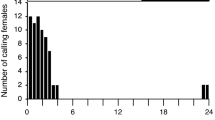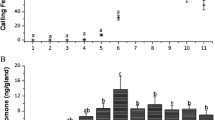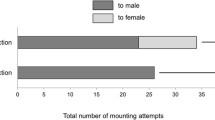Summary
Females of all ages, castes, and prior mating experiences elicited sexual behavior in males of the social waspPolistes fuscatus (F.). The venoms of workers, queens, uninseminated gynes more than 24 hours old, and inseminated gynes more than 14 days old were effective in stimulating male sexual behavior, and thus contained sex pheromone. The venom of gynes less than 15 hours old did not stimulate a significantly greater frequency of male sexual behavior than did the control.
Zusammenfassung
Weibchen jeden Alters, Kasten als wohl als solche mit früherer Kopulationserfahrung verursachten geschlechtliches Verhalten bei Männchen der sozialen WespePolistes fuscatus (F.). Gifte der Arbeiter, Königinnen, unbefruchteten Weibchen > 24 Stunden alt und befruchtete Weibchen > 14 Tage alt waren wirksam und riefen männliches sexual Verhalten hervor. Aus diesem Grunde enthalten diese Gifte Geschlechtspheromone. Gift von Weibchen < 15 h alt riefen kein heufigeres Geschlechtsverhalten hervor als Kontrol-Weibchen.
Similar content being viewed by others
References
Alcock J., 1981. — Notes on the reproductive behavior of some Australian thynnine wasps (Hymenoptera: Tiphiidae).J. Kansas Entomol. Soc., 54, 681–693.
Boch R., Shearer D.A., Young J.C., 1975. — Honeybee pheromones: field tests of natural and artificial queen substance.J. Chem. Ecol., 1, 133–148.
Butler C.G., 1971. — The mating behaviour of the honeybee (Apis mellifera L.).J. Entomol., 46, 1–11.
Forbes R.S., Daviault L., 1965. — The biology of the mountain-ash sawfly,Pristiphora geniculata (Htg.) (Hymenoptera: Tenthredinidae) in eastern Canada.Can. Entomol., 96, 1117–1133.
Free J.B., 1971. — Stimuli eliciting mating behaviour of bumblebee (Bombus pratorum L.) males.Behaviour, 40, 55–61.
Gary N. 1962. — Chemical mating attractants in the queen honeybee.Science, 136, 773–774.
Gibo D.L. 1977. — A method for rearing various species of social wasps of the genusPolistes (Hymenoptera: Vespidae) under controlled conditions.Can. Entomol., 109, 1013–1015.
Jeanne R.L., 1980. — Evolution of social behavior in the Vespidae.Ann. Rev. Entomol., 25, 371–396.
Metcalf R.A., 1980. — Sex ratios, parent-offspring conflict, and local competition for mates in the social waspsPolistes metricus andPolistes variatus.Am. Nat., 116, 642–654.
Michener C.D., 1974. —The social behavior of the bees, a comparative study. Harvard University Press, Cambridge, Mass., 404 p.
Noonan K.M., 1978. — Sex ratio of parental investment in colonies of the social waspPolistes fuscatus.Science, 199, 1354–1356.
Post D.C., Jeanne R.L., 1983a. — Venom: Source of a sex pheromone in the social waspPolistes fuscatus (Hymenoptera: Vespidae)J. Chem. Ecol., 9, 259–266.
Post D.C., Jeanne R.L., 1983b. — Male reproductive behavior of the social waspPolistes fuscatus (Hymenoptera: Vespidae).Z. Tierpsychol., 62, 157–171.
Post D.C., Jeanne R.L., 1984. — Venom as an interspecific sex pheromone, and species recognition by a cuticular pheromone in paper waspsPolistes (Hymenoptera: Vespidae).Physiol. Entomol., 9, 65–75.
Ross K.G., 1983. — Laboratory studies of the mating biology of the eastern yellowjacket,Vespula maculifrons (Hymenoptera: Vespidae).J. Kansas Entomol. Soc., 56, 523–537.
Schöne H., Tengö J., 1981. — Competition of males, courtship behaviour and chemical communication in the digger waspBembix rostrata (Hymenoptera: Sphecidae).Behaviour, 77, 44–66.
Shorey H.H., 1977. — Pheromones. In:How animals communicate, ed. T.A. Sebeok, p. 137–163, Indiana University Press, Bloomington, 1128 p.
Vinson S.B., 1978. — Courtship behavior and source of a sexual pheromone fromCardiochiles nigriceps.Ann. Entomol. Soc. Am., 71, 832–837.
West-Eberhard M.J., 1969. — The social biology of polistine wasps.Misc. Publ., Mus. Zool., Univ. Mich., 140, 1–101.
Author information
Authors and Affiliations
Rights and permissions
About this article
Cite this article
Post, D.C., Jeanne, R.L. Sex Pheromone inPolistes fuscatus (Hymenoptera: Vespidae): Effect of age, caste and mating. Ins. Soc 32, 70–77 (1985). https://doi.org/10.1007/BF02233227
Received:
Accepted:
Issue Date:
DOI: https://doi.org/10.1007/BF02233227




